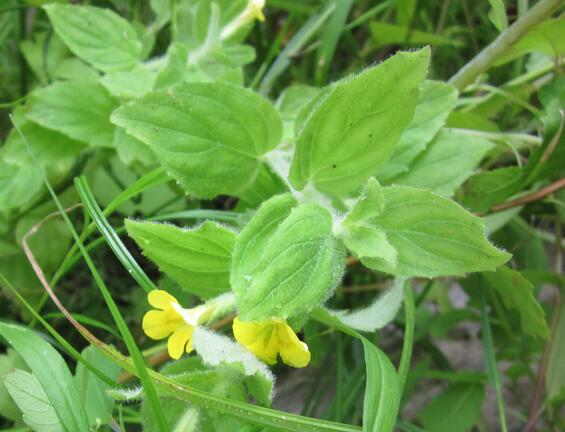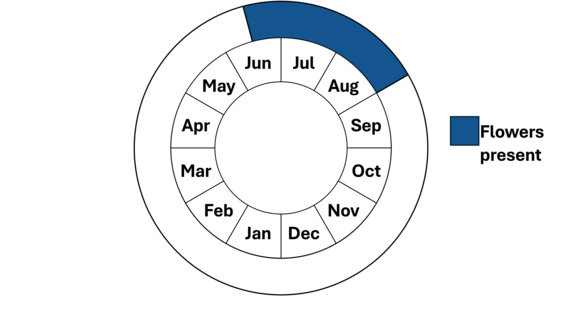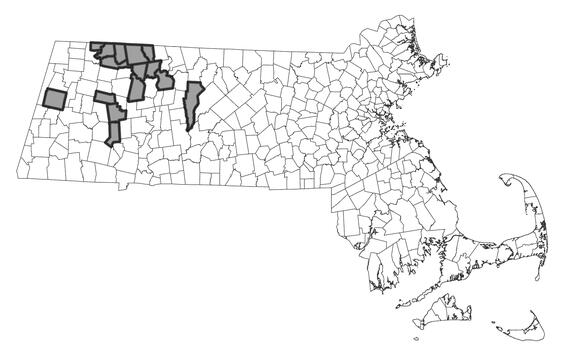- Scientific name: Erythranthe moschata
- Synonymy: Mimulus moschatus (Dougl.)
- Species of Greatest Conservation Need (MA State Wildlife Action Plan)
- Threatened (MA Endangered Species Act)
Description
Muskflower is a yellow-flowered, herbaceous perennial with sticky stems and leaves and a musk-like scent in the lopseed family (Phrymaceae). It typically grows in wet soil along brooks and springs.
Muskflower has opposite leaves and irregularly shaped flowers. Plants are typically 20-40 cm (8-16 in) tall with weak stems that are creeping at the base and erect at the tips. Stems and leaves are villous (hairy) and viscid (sticky) throughout. The leaves are thin, short-petioled (stalked), and 3-6 cm (1-2.5 in) long. The yellow, 5 petaled showy flowers occur singly on long pedicels (stalks) that arise from the axils of the leaves. Flowers are tubular and two-lipped with fine dark lines that run over the base of the yellow lobes. There are small brownish-red spots along the inside edge of the tube. The calyx (outer floral whorl, sepals) is tubular with narrow, triangular lobes. The fruit is a cylindric capsule (a type of dry fruit that opens to discharge its seeds). Although the common name indicates that the plants have a musk scent, these plants may or may not have a scent.
Muskflower could be confused with seep muskflower (Erythranthe guttata) which may be purchased as a garden plant and has been observed growing wild in western Massachusetts. A primary difference is the size of the corolla, which is 25-45 mm (1-1.8 in) long, which is much larger compared to muskflower’s corolla that is 17-22 mm (0.67-0.87 in) long.
Erythranthe moschata plant in bloom. Image by Bruce Sorrie.

Erythranthe moschata blooming plant showing pubescence on leaves, stems and flower. Image by Karen Searcy.
Life cycle and behavior
Muskflower is a short-lived perennial herb. Its blooms in mid-June through August. It produces seed in a capsule that releases seed via the wind and water over a period of time. The seed germinate soon after release, except the seed from late blooming plants will germinate the following year. Mature plants will root at leaf nodes when they are in contact with damp soil and can sprout from stem pieces of plants that break off. The species prefers a low level of natural or anthropogenic disturbance regularly which helps to keep its habitat open.

Population status
Muskflower is listed under the Massachusetts Endangered Species Act as threatened. All listed species are protected from killing, collecting, possessing, or sale and from activities that would destroy habitat and thus directly or indirectly cause mortality or disrupt critical behaviors. There are currently 14 occurrences in the state verified since 1999 found in Berkshire, Franklin, Hampshire and Worcester Counties. Only 4 populations were considered sizable and healthy and likely to last.

Distribution in Massachusetts. 1999-2024. Based on records in the Natural Heritage Database.
Distribution and abundance
Muskflower is predominately a species of the western Canada in British Columbia where it grows in cold bogs and along cold streamlets. It was thought to be much more widespread until genetic studies on plants in the west determined there were several species. It now has disjunct range that includes Wyoming (vulnerable), Colorado (imperiled), Vermont (vulnerable), Massachusetts (imperiled), Virginia (presumed extirpated), and Pennsylvania which has not ranked it. It is considered introduced in Quebec and critically imperiled in Ontario.
Habitat
Muskflower occurs in springs, riverside seeps and wet roadside ditches. It is an excellent indicator of riverside seep communities which are a priority natural community for protection in Massachusetts. In Massachusetts, muskflower is typically found growing at the base of steep riverbanks in pockets of sand, gravel, and mud between boulder and rocks. Muskflower is commonly associated with a mixture of moisture-loving mosses, liverworts, and perennial herbs, such as rattlesnake grass (Glyceria canadensis), scabrous sedge (Carex scabrata), shining ladies’-tresses (Spiranthes lucida), arrow-leaved tearthumb (Persicaria sagittata), seep starwort (Stellaria alsine), willow-herb (Epilobium sp.), wild forget-me-not(Myosotis laxa), American speedwell (Veronica americana), marsh bellflower (Palustricodon aparinoides), bulblet water-hemlock (Cicuta bulbifera), St. John’s-wort (Hypericum spp.), and orange jewelweed (Impatiens capensis). Associated shrubs include meadowsweet (Spiraea alba var. latifolia) and mountain alder (Alnus alnobetula ssp. crispa;a species of special concern).
Healthy habitats are vital for supporting native wildlife and plants. Explore habitats and learn about conservation and restoration in Massachusetts.
Threats
Factors contributing to the rarity of this species include limited habitat, non-native invasive species, human manipulation of hydrology, and habitat succession. It is vulnerable to environmental stresses, particularly droughts (Ewing 2001). Climate change may impact this species through higher than previously normal storm events leading to flooding and scouring of riverbanks where this species occurs. In addition, climate change induced droughts are also likely to be longer which this species does not seem to tolerate. It is thought that muskflower does not produce a long-lived seed bank.
Conservation
Survey and monitoring
Survey and monitoring of muskflower are needed on a regular basis so that population numbers and threats can be assessed, and if management actions are needed, they can be identified and implemented in a timely manner. As this species will move around in its habitat some, it is good to survey populations every 3 to 7 years. This species is best surveyed when flowering in July and August.
Management
As for many rare species, exact needs for management of muskflower are not known. To prevent muskflower’s extirpation from the Commonwealth, it is critical that its habitat remain intact. Muskflower is typically found growing at the base of steep hillsides along rivers and streams. Alteration to the hillsides (such as could occur from logging or construction activities) could result in slope instability and slumping that would negatively impact muskflower populations. Known populations of muskflower in Massachusetts occur along rivers and streams that experience periodic flooding. Disturbance by seasonal flooding may be necessary to perpetuate muskflower populations by limiting shrub growth and maintaining an open community structure. Any alteration of stream or river hydrology should be avoided in areas where muskflower occurs. Muskflower also appears to be negatively impacted by shading and crowding from aggressive invasive plant species like Japanese knotweed (Polygonum cuspidatum). Efforts should be made to eradicate Japanese knotweed where it is impacting muskflower populations. All active management of rare plant populations (including invasive species removal) is subject to review under the Massachusetts Endangered Species Act and should be planned in close consultation with MassWildlife’s Natural Heritage & Endangered Species Program.
Research needs
As noted by Ewing (2001) in the Mimulus moschatus (Musk Flower) Conservation and Research Plan,
“There has never been agreement as to whether this taxon is a true native in New England. In the early 19th century, it was collected in the West, cultivated in Great Britain, and later cultivated in Eastern Canada and New England. Since it was first officially documented in New England in 1902, it has not been clear whether the populations found were native plants or escaped cultivars. Even botanists who believe that the species is native to New England tend to feel that certain populations may be native and others may be introduced. For that reason, this conservation plan recommends that DNA and morphological research be conducted to determine which populations are native and which are escaped from cultivation”.
DNA analysis was completed on populations of muskflower in the western United States and it was found that several similar looking species made up the population. DNA analysis should also be completed on the populations in Massachusetts, comparing them to the DNA from Colorado and Wyoming, which is published and available. Additional research is needed on the long-term viability of its seed under differing conditions.
References
Ewing, B. C. 2001. Mimulus moschatus (Musk Flower) Conservation and Research Plan. New England Wild Flower Society, Framingham, Massachusetts, USA. https://newfs-society.s3.amazonaws.com/documents/Mimulusmoschatus.pdf Accessed 4/10/2025.
Fernald, M. L. 1950. Gray’s Manual of Botany, Eighth (Centennial) Edition—Illustrated. American Book Company, New York.
Gleason, Henry A., and Arthur Cronquist. Manual of Vascular Plants of Northeastern United States
and Adjacent Canada, Second Edition. Bronx, NY: The New York Botanical Garden, 1991.
Haines, A. 2011. Flora Novae Angliae – a Manual for the Identification of Native and Naturalized Higher Vascular Plants of New England. New England Wildflower Society, Yale Univ. Press, New Haven, CT.
NatureServe. 2025. NatureServe Network Biodiversity Location Data accessed through NatureServe Explorer [web application]. NatureServe, Arlington, Virginia. Available https://explorer.natureserve.org/. Accessed: 4/10/2025.
POWO (2025). Plants of the World Online. Facilitated by the Royal Botanic Gardens, Kew. Published on the Internet; https://powo.science.kew.org/ Accessed: 4/10/2025.
Seymour, Frank C. 1969. The Flora of New England, First edition. Charles E. Tuttle Company, Inc. Tokyo, Japan.
Staudinger, M.D., A.V. Karmalkar, K. Terwilliger, K. Burgio, A. Lubeck, H. Higgins, T. Rice, T.L. Morelli, A. D'Amato. 2024. A regional synthesis of climate data to inform the 2025 State Wildlife Action Plans in the Northeast U.S. DOI Northeast Climate Adaptation Science Center Cooperator Report. 406 p. https://doi.org/10.21429/t352-9q86
Contact
| Date published: | May 8, 2025 |
|---|